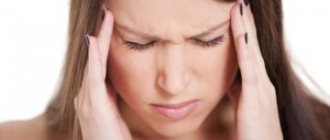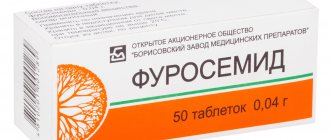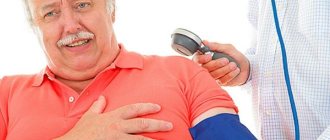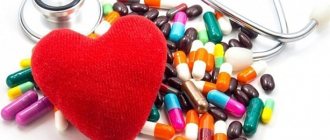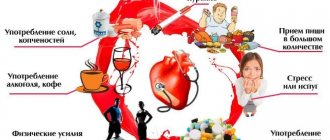What is a hypertensive crisis?
Hypertensive crisis (HC) is a sudden increase in blood pressure, accompanied by certain clinical manifestations and requiring its immediate reduction to prevent damage to target organs.
Every year, a hypertensive crisis develops in 1 - 5% of patients suffering from arterial hypertension.
The target organs for arterial hypertension are: the brain, kidneys, heart, blood vessels and retina. These organs are primarily negatively affected by high blood pressure.
Epidemiology
Arterial hypertension has been and remains one of the most common diseases in Russia. About 40% of the adult population of our country suffer from high blood pressure.
Hypertensive crises most often occur with irregular use of antihypertensive drugs. A distinctive feature of the Civil Code is the possibility of its repetition:
- 62.7% of hypertensive crises recur within a year;
- 39.6% - within the next month;
- 11.7% - within 48 hours.
Relaxation methods
Quite often, the cause of hypertension is a negative stressful situation. The release of adrenaline leads to vasoconstriction and increased blood pressure. There are a lot of modern methods of how to avoid the occurrence of a hypertensive crisis. Motherwort, valerian, and lemon balm are among the herbs that have a sedative effect.
Reliable methods of relaxation include yoga, physical therapy, and listening to calm, pleasant music. Proper breathing during yoga helps to calm down and reduce blood pressure. During group classes, cortisol levels drop, which, according to scientific data, leads to pressure surges.
A hypertensive crisis does not happen without a reason and most often patients struggle with high blood pressure for a long time. Proper nutrition and avoidance of fatty, spicy and salty foods will help the heart cope with the load. If the patient knows all the ways to prevent a hypertensive crisis, he is warned, it is much easier for him to cope with high blood pressure and avoid the serious consequences of the pathology.
Classification of hypertensive crisis
- Complicated crises are conditions that pose a threat to the patient’s life.
Complications of hypertensive crisis:
- hypertensive encephalopathy – dysfunction of the brain due to hypertension;
- preeclampsia and eclampsia in pregnant women. Preeclampsia occurs after the 20th week of pregnancy and is characterized by hypertension and protein excretion in the urine. Eclampsia is an extremely dangerous condition, which is accompanied by the development of generalized seizures in a pregnant woman;
- cerebral stroke is a disruption of the blood supply to an area of the brain due to blockage of a vessel by an embolus (ischemic stroke) or hemorrhage into the substance or membrane of the brain (hemorrhagic stroke);
- Dissecting aortic aneurysm is an acute condition characterized by rupture of the inner lining of the aorta and its dissection under the influence of high blood pressure. At any moment, the entire artery wall can rupture and cause massive blood loss, which can be fatal;
- acute left ventricular failure - a pathological condition caused by a sharp decrease in the contractility of the left half of the heart;
- hypertensive crisis with pheochromocytoma. Pheochromocytoma is a hormonal tumor, most often of the adrenal glands, which synthesizes catecholamines - adrenaline and norepinephrine;
- acute coronary syndrome is a group of clinical symptoms in patients with coronary heart disease, allowing one to suspect unstable angina or myocardial infarction.
- Uncomplicated crises have pronounced clinical symptoms, but pass without affecting the function of target organs.
Treatment
How to treat a hypertensive crisis, what medications to take is decided by the attending physician.
Medicines for a hypertensive crisis are selected individually for the patient, taking into account possible complications of antihypertensive treatment, decreased cerebral circulation and the development of ischemic stroke. Drugs for hypertensive crisis are prescribed depending on the symptoms. With severe symptoms of damage to the nervous system, a sharp decrease in pressure can worsen the patient's condition. Drugs that have a moderate hypotensive effect are used.
In case of hypertensive crisis in cardiac patients, ACE inhibitors are used. The use of certain drugs is contraindicated for cardiac patients - clonidine is not used for sick sinus syndrome, bradycardia, atrioventricular block (II-III), the drug is contraindicated for depression, acute myocardial infarction, severe encephalopathy. Eufillin is not used in patients with epilepsy, frequent extrasystole, or paroxysmal tachycardia. In case of acute left ventricular failure during a hypertensive crisis, patients are prescribed diuretics, which complement and enhance the hypotensive effect of drugs for hypertension.
If a complicated hypertensive crisis develops, intensive therapy is carried out with careful monitoring of heart rate, blood pressure, and an ECG is performed, which helps to timely determine the development of bradycardia, heart block and other complications. When symptoms of damage to the kidneys, heart, or brain appear, the patient is admitted to the intensive care ward, where he is given urgent care, medications are carefully selected and dosed. The main groups of drugs for the treatment of hypertension are ACE inhibitors, beta blockers, diuretics, alpha blockers, calcium channel blockers.
Etiology and pathogenesis
The causes of hypertensive crisis are:
- excessive physical activity;
- severe psychological stress;
- influence of meteorological conditions;
- increased consumption of table salt;
- alcohol abuse;
- use of oral contraceptives;
- abrupt withdrawal of antihypertensive drugs;
- acute ischemic stroke;
- resuscitation measures during and after surgery;
- in women during menopause;
- exacerbation of coronary heart disease;
- sleep apnea syndrome;
- drug use (LSD, amphetamine);
- eclampsia and preeclampsia in pregnant women.
With arterial hypertension, patients should take antihypertensive drugs regularly. The main reason for the development of a hypertensive crisis is non-compliance with the regimen of taking them.
Reasons for the development of hypertensive crisis in older people:
- emotional overstrain and severe stress;
- sudden changes in weather conditions;
- alcoholic excess;
- refusal to take antihypertensive drugs prescribed by a doctor;
- irrational use of pharmacological drugs;
- diet violation.
Pathogenesis
A hypertensive crisis in pathogenesis has two components:
- vascular - with an increase in total peripheral vascular resistance, an increase in blood pressure occurs due to sodium retention and neurohumoral mechanisms;
- cardiac - in response to an increase in heart rate and circulating blood volume, the heart increases the volume of blood ejected, which also leads to an even greater rise in blood pressure.
Clinical picture
Hypertensive crisis symptoms are varied and require a differentiated approach.
The main signs of a hypertensive crisis:
- sharp and sudden development - from several minutes to hours;
- the blood pressure numbers at which a hypertensive crisis develops can vary greatly;
- complaints of severe headaches and dizziness;
- nausea, vomiting;
- visual impairment, up to the development of transient blindness;
- patients may complain of flies flashing before their eyes;
- There may be numbness of the hands and face, with loss of pain sensitivity;
- paresis of the limbs is possible for up to one day;
- convulsions;
- pain in the heart area, a feeling of palpitations and interruptions, as well as the development of shortness of breath;
- feeling of intense fear;
- severe sweating;
- a sensation of heat may develop.
Symptoms
During a hypertensive crisis, blood pressure rises sharply, and the symptoms of arterial hypertension worsen. Blood pressure can rise to 180/110, 230/130 and higher.
A certain part of patients with arterial hypertension get used to high blood pressure and practically do not feel a blood pressure of 200/110, feel only a slight malaise, and continue to perform their duties.
A hypertensive crisis is characterized by a sharp increase in blood pressure, which is accompanied by severe headache, nausea, vomiting, tinnitus and other symptoms.
Often the development of a hypertensive crisis is preceded by certain symptoms:
the patient cannot sleep, worries, feels depressed, and gets irritated for no reason. Then the minimum and maximum pressure increases over a short period of time, and a headache of varying intensity begins to bother you.
During a hypertensive crisis, brain symptoms appear:
nausea and vomiting, severe headache. Such manifestations indicate increased intracranial pressure. Headache can occur in the area of the back of the head, crown, temples, forehead, and a feeling of numbness of the skin in the area of the back of the head and neck. The pain can be throbbing, dull, sharp, paroxysmal, or constant. This may indicate a cerebral circulatory disorder.
Some of the most common symptoms of a hypertensive crisis
– this is pain in the heart area, a feeling of squeezing, severe shortness of breath, arrhythmia. The pain may radiate to the shoulder blade, left arm, and be accompanied by nausea. During a hypertensive crisis, pain may occur in the abdominal area, and the patient often begins to limp. A hypertensive crisis is characterized by symptoms of disruption of the autonomic and central nervous systems: severe irritability appears, the patient is excited, red spots are visible on the skin of the neck and chest, the skin becomes moist. Chills begin, body temperature rises, and muscle tremors bother you.
In some cases, depression of the nervous system occurs and the patient becomes lethargic, indifferent, and constantly sleeps. A hypertensive crisis with a sharp depression of the nervous system can be accompanied by muscle twitching and cramps; the patient is in a coma between attacks. The patient develops speech disorder and decreased sensitivity of the limbs. Disorders of the cardiovascular system manifest themselves in the form of a variety of symptoms:
- Tachycardia or bradycardia
- Heart rhythm disturbances
- Muffled heart sounds, congestive wheezing in the lower parts of the lungs
- The ECG shows depression of the ST segment and flattening of the G wave - signs of systolic overload of the left ventricle of the heart.
During a hypertensive crisis, the appearance of red blood cells and protein in the urine is noted, and blood circulation in the kidneys deteriorates.
Diagnostics
The main method for diagnosing a hypertensive crisis is measuring blood pressure with a tonometer.
Rules for measuring blood pressure:
- the patient should sit in a comfortable position;
- the hand should be on the table and at heart level;
- the tonometer cuff is placed on the shoulder, and its lower edge should be 2 cm above the bend of the arm;
- Blood pressure should be measured at rest after a 5-minute rest.
As a rule, HA develops at a systolic blood pressure level of 180 mmHg, and a diastolic blood pressure level above 100 - 120 mmHg. (in young people, a hypertensive crisis also develops at lower blood pressure levels).
Main criteria for hypertensive crisis:
- sharp and sudden onset;
- high blood pressure numbers;
- characteristic clinical symptoms are headache, dizziness and nausea.
Instrumental diagnostics
- ECG;
- magnetic resonance imaging;
- CT scan.
Differential diagnosis
Hypertensive crisis must be differentiated from the following conditions:
- A panic attack (vegetative crisis) is an attack of severe anxiety and fear, combined with vegetative symptoms - rapid heartbeat, high blood pressure, severe sweating, choking, trembling throughout the body, dizziness and nausea. Despite the similar clinical symptoms with hypertensive crisis, there are also differences. Thus, with GC, the patient usually suffers from arterial hypertension and without taking antihypertensive drugs, blood pressure does not decrease, and with a vegetative crisis, blood pressure returns to normal without taking medications after the end of the attack. Usually a panic attack lasts about 10 - 15 minutes, but an obsessive feeling of fear of a repetition of the attack haunts the patient constantly;
- Tension headache is a condition characterized by a bilateral widespread headache with a compressive nature. Tension headaches are not worsened by physical activity and are not accompanied by nausea and dizziness;
- Cluster headache is a very severe pain syndrome in the head area that occurs without any reason and irregularly. The strength of the headache is so enormous that there are even known cases of suicide to get rid of the torment. The pain occurs in series, that is, in clusters - several attacks a day for weeks or months and suddenly disappear;
- delirium delirium is an acute mental condition caused by the toxic effects of alcohol on the body. It usually occurs after the cessation of binge drinking during abstinence. Clinically characterized by the patient having visual and auditory hallucinations, agitation, sweating, increased blood pressure, tremor and muscle weakness;
- hyperthyroidism is a condition characterized by an increase in the level of thyroid hormones in the blood, resulting from dysfunction of the thyroid gland. The main symptoms of hyperthyroidism are severe excitability, nervousness, tachycardia, arterial hypertension, eye symptoms - bulging eyes, swelling of the eyelids and constant lacrimation;
- Cushing's syndrome is an endocrine disorder caused by increased levels of glucocorticoid hormones in the blood. Characteristic symptoms of this condition are obesity, moon face, hypertension, osteoporosis, muscle weakness, purple stretch marks on the chest, abdomen and thighs, as well as excess hair growth in women;
- acute coronary syndrome - a group of clinical symptoms in patients with coronary heart disease, allowing one to suspect myocardial infarction or unstable angina;
- Ischemic stroke is a circulatory disorder with damage to brain tissue and disruption of its function.
The first signs of illness
As a rule, all forms of hypertensive crisis (with the exception of convulsive crisis, which occurs suddenly) are accompanied by the appearance and increase of symptoms according to the following pattern: a headache appears, which has a different character (from acute to slow-stringing, pulsating), then the person’s general well-being worsens, followed by “ dizziness and the appearance of “floaters” in the eyes are activated, sweating increases, deterioration of vision and hearing progresses, after which, depending on the form of the hypertensive crisis, the person may lose consciousness / begin to choke / have convulsions (due to oxygen starvation of the brain).
Further, depending on the type of illness, the attack can increase gradually, up to several days, during which all the above symptoms are noted. In this case, the following manifestations are added to the list of symptoms: increased nervous excitability of a person, increased anxiety, spread of red spots throughout the body (especially on the arms and chest), and impaired coordination of the patient.
Sometimes, on the contrary, an attack occurs sharply, suddenly, and has serious consequences. This usually refers to the convulsive form of the crisis (hypertensive encephalopathy). The consequences that it entails are different, but all are equally severe: pulmonary or cerebral edema, cardiac asthma, acute heart failure, as well as myocardial infarction and stroke.
The end of an attack of hypertensive crisis is often, according to the observations of the patients themselves, accompanied by increased urination, during which the urine is light and sometimes transparent.
Treatment of hypertensive crisis
Treatment of a hypertensive crisis in a complicated course should be carried out exclusively in emergency cardiology departments and intensive care units.
Hypertensive crisis treatment varies, depending on its type.
Uncomplicated hypertensive crisis - treatment
To treat this type of GC, tablet forms of drugs are used. It is important to start therapy immediately.
The rate of decrease in blood pressure in the first two hours after a crisis should not exceed 25% of the initial blood pressure.
Relief of a hypertensive crisis is carried out with the following drugs.
- Captopril - the patient is given a tablet either under the tongue or taken. The effect occurs within 5 minutes after application and lasts up to 4 - 8 hours. This drug belongs to angiotensin converting enzyme inhibitors.
- Carvedilol - used orally, has a pronounced vasodilating effect, due to which blood pressure levels decrease. This drug is a non-selective beta-blocker.
- Nifedipine - used sublingually or orally. It has a relaxing effect on the smooth muscles of blood vessels, thereby leading to their expansion and lowering blood pressure. The drug is short-acting and is used exclusively to relieve an attack.
- Amlodipine - used orally, the drug has a long-term effect.
- Furosemide is a diuretic, also used in tablet form orally.
All of the above drugs are used to treat uncomplicated hypertensive crisis.
Treatment of complicated hypertensive crisis
When treating complicated GC, the choice of tactics depends on target organ damage. Intravenous administration of drugs is used.
A complicated hypertensive crisis requires immediate hospitalization in the intensive care unit.
Drugs used to relieve GC:
- Sodium nitroprusside;
- Nitroglycerine;
- Enalaprilat;
- Furosemide;
- Metoprolol;
- Esmolol;
- Urapidil;
- Clonidine.
Treatment options
If there is a strong jump in pressure to a critical level, it is necessary to ensure complete rest. All physical activity is excluded. Emergency treatment with medications is also needed. Purpose:
- reduce blood pressure gradually;
- stabilize the functioning of the cardiovascular system;
- protect organs that may be damaged due to the crisis.
The following groups of medications are used as emergency aid:
- calcium channel blockers – Corinfar. Drugs lower blood pressure;
- vasodilators – Vinpocetine, Nitroglycerin. Medicines dilate blood vessels;
- ACE inhibitors - Enap, Enam, Enalapril, Captopril, Capoten. Medicines lower blood pressure and are also used for the treatment and prevention of heart and kidney failure.
Additionally, the specialist may prescribe other medications. The main thing during a crisis is to reduce blood pressure gradually:
- the first hour – by 20–25% of the initial indicator;
- for the next 2–4 hours, the pressure should be no more than 160/100 mmHg.
If the hypertensive crisis is complicated, most often specialists prescribe therapy with medications for intravenous use.
Products for internal use are not prescribed, as they are absorbed more slowly. In patients with a complicated form, vomiting is constantly present, and such drugs simply will not be absorbed.
Treatment of a hypertensive crisis that does not threaten the patient’s life should be comprehensive. The following methods can be used as therapy:
- medicines. The patient is prescribed diuretics, analgesics, antiemetics, sedatives, and antihypertensives;
- diet. The point plays an important role in restoring the functioning of the cardiovascular system and other organs. But you shouldn't go on a diet. It is enough to exclude alcoholic and stimulating drinks, smoking, sweets, and soda. It is recommended to steam, bake or boil food. Salted, smoked and fried foods are not allowed. It is recommended to add more vegetables, fruits, lean meats and dairy products to your diet. You should eat 5-6 times a day with breaks of 2-3 hours, and portions should be 200-300 g;
- folk remedies;
- additional procedures - warm heating pad to the feet, mustard plasters, hirudotherapy (treatment with leeches).
Folk remedies
Before using unconventional methods, you should consult a specialist. Even despite their natural composition, such products can cause an allergic reaction if you are hypersensitive to the components. Popular recipes:
- valerian or motherwort. The recipe will be useful if blood pressure rises due to stress. You need to take 1 tbsp. dry herbs, pour 1 glass of hot water. Filter after 20 minutes, take 40–50 ml 3 times a day. Course of use – until blood pressure normalizes;
- honey and garlic. The recipe is well suited for high blood pressure that deviates slightly from the norm. You should mix the ingredients in equal quantities and take 1 tbsp. if the indicator increases. To achieve maximum effect from use, it is recommended to use the method for a long time. In this case, you need to take the mixture 1 tbsp. 2 times a day;
- Apple vinegar. If the pressure rises sharply, you need to take a cloth and moisten it with a 5% solution of the product. Next, apply the mixture to your heels and leave for 10–15 minutes.
Folk remedies will be most effective in complex therapy, and not during individual use. It is necessary to combine alternative medicine with bed rest and diet.
Prevention of hypertensive crises
Basic methods of preventing GC:
- Patients with arterial hypertension need to constantly monitor blood pressure numbers. It is necessary to measure blood pressure at least 2 times - in the morning and in the evening, regardless of the general condition;
- regularly take medications that lower blood pressure as prescribed by your doctor;
- avoid psycho-emotional stress and get more rest;
- apply moderate physical activity.
Cardiologists recommend daily 30-minute walking to strengthen the heart and blood vessels;
- It is necessary to completely abandon bad habits - alcohol and smoking. The negative effects of alcohol and tobacco have been scientifically proven;
- strive to reduce body weight, since obesity increases the risk of developing a complicated hypertensive crisis;
- reduce the consumption of table salt, since its excessive use leads to an increase in fluid in the body and, accordingly, an increase in blood pressure.
